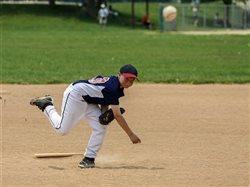
In baseball, overuse injuries plaguing more young athletes
(BPT) – While concussions have garnered much of the spotlight when it comes to health concerns among young athletes, there is another rising issue among children who play sports that has health professionals just as concerned.
Injuries in young athletes are on the rise, and elbow and shoulder injuries in children are on the verge of becoming an epidemic. The American Orthopaedic Society for Sports Medicine’s STOP Sports Injuries reports that thousands of children are seen each year complaining of elbow or shoulder pain. Damage or tear to the ulnar collateral ligament (UCL) has become the most common injury suffered and is often caused by pitchers throwing too much. According to records from the American Sports Medicine Institute, the number of surgeries to reconstruct the UCL – or Tommy John surgery (named for the first pitcher to ever receive the procedure) – on youth pitchers has more than doubled over the past 16 years.
‘Baseball is generally a very safe game to play at all ages, but research shows that pitching too much – particularly at a young age – can increase risk of injuries,’ says Jeffrey R. Dugas, M.D., of Andrews Sports Medicine & Orthopaedic Center. ‘Research has shown that kids who pitch more than 100 innings during a calendar year – whether that’s for one team or multiple teams – are 3.5 times more likely to have a serious elbow or shoulder injury leading to surgery than those who don’t.’
If a young athlete is throwing too hard, too much, too early, and without rest, a serious elbow or shoulder injury may be on the horizon. Overuse and stress-related problems can affect not only soft tissue like muscles, tendons and ligaments, but also growing parts of bone, and if the condition is not treated, it could cause deformity of the limb and permanent disability.
In 2014, Major League Baseball, in partnership with USA Baseball, and with input from top sports medicine physicians and researchers, launched ‘Pitch Smart,’ an arm-safety initiative for youth players. A series of practical, age-appropriate guidelines to help parents, players and coaches avoid overuse injuries, these guidelines advise a maximum pitch count of 50 for 7- to 8-year-olds, increasing incrementally up to 120 pitches by age 22.
While the guidelines have been adopted by most national amateur baseball programs, including Little League, which has had similar guidelines in place since 2007, and most recently by the National Federation of State High School Associations (NFHS), a problem is that many young baseball players are playing on more than one team at a time.
Dr. Cain’s best advice to parents and players: Don’t play year-round baseball or on more than one baseball team at the same time, and don’t specialize in one sport until senior year in high school. He offers additional baseball injury prevention tips:
* Warm up properly by stretching, running, and with easy, gradual throwing.
* Don’t pitch on consecutive days.
* Play a variety of positions besides pitcher (but not catcher).
* Concentrate on age-appropriate pitching, mastering the fastball first and the change-up second, before considering breaking pitches.
* Emphasize control, accuracy and good mechanics – not speed.
* Communicate regularly about how your arm is feeling and if there is pain.
* Don’t pitch with elbow or shoulder pain. If the pain persists, see a doctor.
Cain says the best thing parents can do is to talk to their kids in a way that fosters open communication on their part. Children really want to please their parents, teammates and coaches, and may hide injuries if they feel it will let everyone down.
‘Build a rapport and trust, because if you can catch some of these things early, when it is just soreness, you can shut them down for a few days or tweak the training and avoid a major injury and major surgery,’ he says. ‘Kids will open up if they can trust you and know you are looking out for them.’
‘Speak with a sports medicine professional or athletic trainer if you have any concerns about baseball injuries or injury prevention strategies.’
For more information on the prevention and treatment of sports injuries and to find an Andrews Sports Medicine and Orthopaedic Center surgeon, visit www.AndrewsSM.com/BaseballInjuryPrevention.


